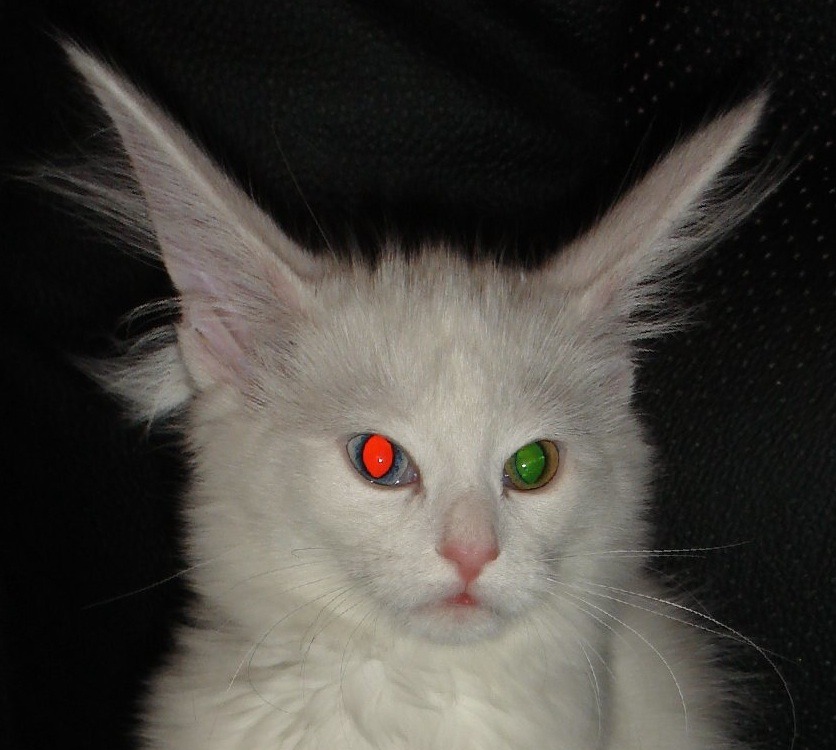The most uncommon cat eye color is hazel or orange. Cats have low melanin levels in their eyes, allowing them to have light-colored eyes. Because of the high levels of melanin in their eyes, feral cats and cats like the Scottish Fold tend to have these eye colors. The pupils of a cat dilate when it is in pain. Depending on the injury or underlying disease, a cat with eye pain may have dilated or constricted pupils. Squinting can also indicate pain in the body or in the eye. Pain can also be indicated by bloodshot eyes.
A medium-sized vertical slit typically indicates a confident, relaxed, and happy cat. The more open or dilated the pupils are at certain times, the more defensive your cat is, the more agitated they are, and the eyes can warn you that they are about to jump away or scratch or bite.
1. Blue-Eyed Cats
Blue-eyed cat breeds include Siamese, Balinese, Himalayan, Persian, Birman, and Javanese. Ragdolls are known for their bright blue eyes, but not all Ragdolls have them. There is also the extremely rare Ojos Azules breed, which can produce cats with dark coats and blue eyes. According to Dr. Leslie Lyons, a professor in the School of Veterinary Medicine, blue eyes in these breeds are not associated with deafness.
Approximately 60% of white-dominant kitties are the result of mutations in the KIT gene. The blue eyes in these cats are caused by a cellular issue: these irises have fewer melanocytes, which are pigment-producing cells. These same cells produce skin pigment and are involved in the inner-ear function. Dr. Lyons believes that cats with fewer melanocytes, such as white cats with blue eyes, may not have enough cells to hear properly. White cats have a genetic makeup like albino humans, who lack pigment; this leaves them vulnerable to UV light.
Certain breeds are distinguished by their distinctive blue eyes just like the Persian which is one of the 8 breeds with big distinct eye wherein these characteristics adds to their rarity making them expensive. Among these are the well-known Siamese and Ragdoll breeds. Blue eyes can also be found in the American Shorthair, British Shorthair, Balinese, Persian, Maine Coon, and Devon Rex. Tonkinese cats have unusual aqua blue eyes that are not found in any other breed.
2. Green-Eyed Cats
Green eyes can be found in breeds such as the Egyptian Mau, which has bright gooseberry green eyes. Havana cats have emerald-green eyes, while Norwegian Forest Cats have a variety of green tones. Russian Blue cats have bright green eyes as well. Green-eyed cats are relatively common in random-bred cats. Melanin in a cat’s iris is distinct from melanin in its fur. This implies that any color cat can have green eyes. Pepper is a tuxedo cat with large areas of black fur that correspond to the highest level of melanin, but his green eyes indicate that his irises have low levels of melanocyte activity.
3. Hazel-Eyed Cats
The hazel eye color in cats is a mix of green and yellow. Most wild cats in temperate regions, including Lynx and Bobcats, have this eye color. It’s also a popular eye color among feral cats. The Abyssinian, Bengal, Singapura, Cornish Rex, and Scottish Fold are all breeds that can have hazel eyes.
4. Yellow and Amber Eyed Cats
The Bengal, American Shorthair, Manx, British Shorthair, LaPerm, Bombay, Sphynx, and Norwegian Forest Cat all have yellow or amber eyes. The Burmese cat breed can have particularly striking golden eyes, with show cats frequently having shades of impressive brilliance and depth. Amber or orange eyes are the rarest eye color for cats, for the same reason that lighter eyes, such as yellow or gold, are so common. It’s all because of the melanin content.
5. Orange-Eyed Cats
Bombay cats are one of the purest black cat breeds because they only come in one color—black! Because of their sleek, shiny, short-haired coats and orange or gold eyes, these cats are often referred to as miniature black panthers or parlor panthers.
Changing color is commonly associated with an eye infection, but it could also indicate a more serious condition. Uveitis, an eyeball inflammation that can cause permanent damage if left untreated, is a common eye condition in cats. Eyes that are abnormally yellow, red, or orange are symptoms. Orange eyes can be found in breeds such as the Devon Rex, Japanese Bobtail, American Wirehair, Maine Coon, and Turkish Van.
6. Copper-Eyed Cats
This is a rarer color than others, and while it can be distinguished from orange, it is equally unusual. Copper eyes can be found in the Japanese Bobtail, Maine Coon, Persian, Cornish Rex, and Chartreux. The color of a cat’s eyes is frequently associated with its breed; for example, blue eyes are common in Siamese cats which is also one of the best cat breeds for first-time owners and a popular breed as well. Copper-colored eyes can indicate that a cat has a liver shunt, a potentially fatal condition that affects their behavior, blood, and health.
7. Odd-colored Eyes
Although it is uncommon, a condition known as heterochromia can cause cats to have two different colored eyes. These odd-eyed cats typically have one blue iris in the colored part of the eye and one green, brown, or yellow iris. Heterochromia can also affect dogs and humans. If your lovely feline’s eyes are two different colors, perhaps yellow and blue, then, you’ve got yourself an odd-eyed kitten.
While congenital heterochromia iridis affects about six people out of every 1,000, and many of those cases are subtle, it is much more common in animals. It’s not uncommon to see it in dogs, and felines with it have their own name: odd-eyed cats. They can have blue eyes, gold eyes, or odd eyes with one of each color, and are extremely rare to find. Many people are curious about and looking for this type of cat which costs between $7,000 and $11,000. It’s extremely rare and believed to be lucky, and many people want to buy it.
8. Dichroic Eyes
It is the presence of two types of functional photoreceptors in the eyes, known as cone cells. Dichromats are organisms that have dichromacy. Dichromats can reproduce any color they see using only two pure spectral lights.
Despite extensive research, the fundamental nature of feline spectral sensitivity remains unknown. Most electrophysiological studies have revealed two photopic receptors within the cat’s retina, one sensitive to longer wavelengths near 560 nm and the other to shorter wavelengths near 460 nm, which serves as the neuroretinal basis for dichromatic vision. However, a few studies have discovered a third photopic receptor that is most sensitive to medium wavelengths between 500 and 520 nm and overlaps in spectral sensitivity with the feline scotopic receptor, potentially allowing trichromatic vision.

